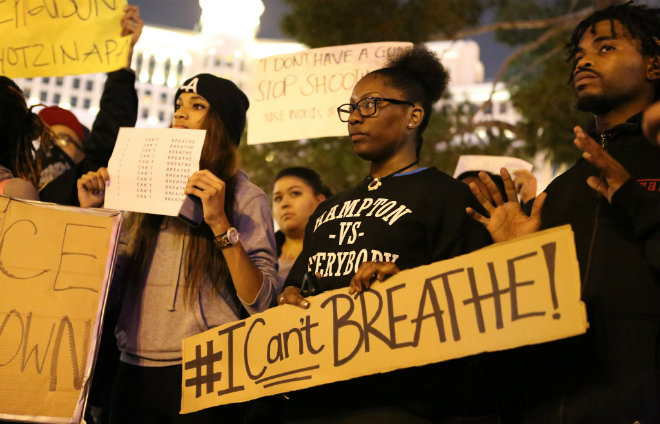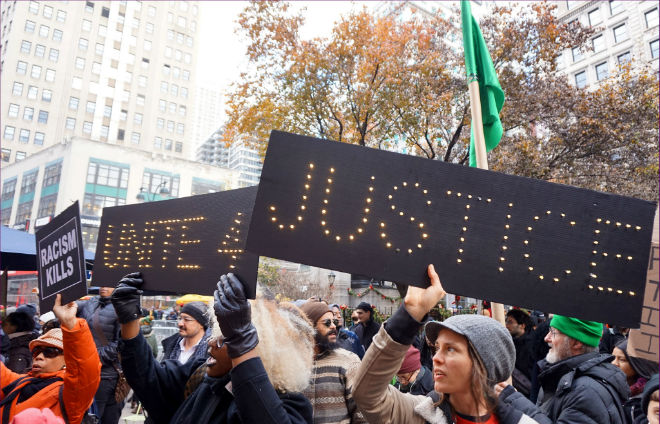Part 5 in a Series
The systematic oppression of black people has been thrust into national consciousness because of the visibility of recent police brutality against black men.
Black Lives Matter (BLM), the emerging social movement challenging this violence and the institutionalized inequalities that underlie and uphold it, started as a hashtag by three black queer women activists. Now it has become a national call to action that has brought thousands of people of diverse racial and cultural backgrounds into the streets to demand immediate changes in police policies and practices.
Pacific Standard, Dec. 19, 2014
 On December 18th (2014), Associate professor Adia Harvey Wingfield of Georgia State University wrote an analysis of the gendering of BLM for the Pacific Standard (PS). We wrote an article the next day, also in PS, on how social scientists can do more to end racial subjugation. Together, these articles offer both a feminist perspective on the movement and a concrete set of ways social scientists can take action.
On December 18th (2014), Associate professor Adia Harvey Wingfield of Georgia State University wrote an analysis of the gendering of BLM for the Pacific Standard (PS). We wrote an article the next day, also in PS, on how social scientists can do more to end racial subjugation. Together, these articles offer both a feminist perspective on the movement and a concrete set of ways social scientists can take action.
Professor Wingfield’s analysis demonstrates how the BLM protests are important not only because they draw attention to ongoing acts of racial persecution, but because they reveal how gender shapes police violence and those who are victimized by it.
- It’s safe to say that the most well-known victims of police (and self-appointed vigilante) violence are black males….
- Black men have historically been and continue to be cast as dangerous, threatening, and inclined to violent behavior. This stereotype has its roots in the post-slavery era when such “violence” was used as a justification for lynching black men.
- The stereotype of black male criminality may have the unintended consequence of making criminal activity more difficult to curtail.
Black women are an untold side of this story.
- The act of protesting itself is a gendered activity, also involving covert forms of protest.
- If police violence is seen as a black men’s issue, then black female victims are easily overlooked and the problem persists.
- Depictions of black men as the primary victims of police violence may make black women reluctant to involve law enforcement.
Read the full article: “Gendering #BlackLivesMatter: A Feminist Perspective” by Adia Harvey Wingfield, Pacific Standard, Dec. 18, 2014.
 On December 19th (2014) we argued, too, that using our knowledge of social systems, all social scientists—black or white, race scholar or not—have an opportunity to challenge white privilege. As social scientists, our job is to understand the social structures within society that reproduce inequities. We can, in tangible ways, bring our sociological imaginations to bear on the eradication of racial repression.
On December 19th (2014) we argued, too, that using our knowledge of social systems, all social scientists—black or white, race scholar or not—have an opportunity to challenge white privilege. As social scientists, our job is to understand the social structures within society that reproduce inequities. We can, in tangible ways, bring our sociological imaginations to bear on the eradication of racial repression.
We can:
- Listen and follow the lead of this black-led movement to confront racial injustice.
- Assess the critical role of law enforcement.
- Create space in our classrooms for dialogue about white privilege and anti-black racism.
- Support social action among our students.
- Incorporate a race lens into our research and writing, and include research on race in our syllabi.
- Share our findings with other colleagues, activists, and our broader communities.
- Open our eyes, look around, and “interrupt oppression” when we see it.
- Talk about the Black Lives Matter movement and engage in critical dialogue to transform our institutions.
- Mobilize anti-racist white people.
- Help to change the system.
Racial justice requires fundamental changes to a system with deep historical roots, one that structurally disadvantages black people as a group. At this critical time, we all have an opportunity to examine ourselves and to support those seeking transparency, accountability, and safety in their communities.
Read the full article: “Social Scientists Can Do More to Eradicate Racial Oppression” by Gayle Sulik and Mindy Fried, Pacific Standard, Dec. 19, 2014.
Read the entire Black Lives Matter Series on Feminist Reflections
- Part 1: Don’t Black Lives Matter? by Gayle Sulik
- Part 2: How Sociologists Can Support Black Lives Matter by Mindy Fried
- Part 3: An Open Letter to Student Activists by Meika Loe
- Part 4: Racism is not Dead: Language And Everyday Interactions by Trina Smith
